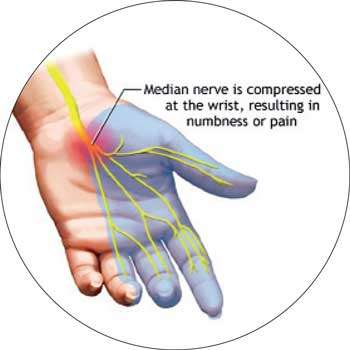08 Feb 2019 - {{hitsCtrl.values.hits}}

 If you are experiencing tingling sensations, a feeling of numbness or weakness of the hands there is a very good chance that you may be suffering from what is known as Carpal Tunnel Syndrome. Carpal Tunnel Syndrome is the most common and widely reported form of ‘entrapment neuropathy’ in the world accounting for over 90% of all neuropathies. In a developed country such as USA alone, this condition has a prevalence of approximately 50 subjects per 1000 per annum and it is fast becoming an important causative factor of occupational disability.
If you are experiencing tingling sensations, a feeling of numbness or weakness of the hands there is a very good chance that you may be suffering from what is known as Carpal Tunnel Syndrome. Carpal Tunnel Syndrome is the most common and widely reported form of ‘entrapment neuropathy’ in the world accounting for over 90% of all neuropathies. In a developed country such as USA alone, this condition has a prevalence of approximately 50 subjects per 1000 per annum and it is fast becoming an important causative factor of occupational disability.
What is Carpal Tunnel Syndrome?
 Carpal Tunnel Syndrome is a mononeuropathy, which means only a single nerve is affected. In this instance- the median nerve.
Carpal Tunnel Syndrome is a mononeuropathy, which means only a single nerve is affected. In this instance- the median nerve.
This nerve plays an integral role in one of the most important functions of life; the opposing thumb, which is essential for carrying out tasks which require precision. It is responsible for sensation (ability to feel) and movements of the thumb, index finger, middle finger and part of the ring finger.
Carpal Tunnel Syndrome takes place when there is compression of the median nerve as it passes into the wrist’s Carpal Tunnel. The Carpal Tunnel is a narrow anatomical passageway on the palm side of your wrist composed of bones and ligaments.
Excessive pressure upon this nerve leads to tingling sensations, infrequent numbness and pain. It can affect one or both hands with the pain sometimes radiating up the affected arm.
Causes
The majority of cases of Carpal Tunnel Syndrome are Idiopathic; which means the underlying cause remains unknown. The other common medical related causes which give rise to this condition are,
•Myxedema (Severely advanced Hypothyroidism)
•Diabetes Mellitus
•Neoplasms (An abnormal and excessive growth of tissue)
•Fractures or trauma to the wrist
•Rheumatoid Arthritis (A form of inflammatory arthritis)
•Amyloidosis (An abnormal buildup of protein in tissues & organs)
•Pregnancy & Menopause (due to fluid retention)
•Obesity Risk
 Research shows that women are more susceptible to this condition than men. The most commonly diagnosed age groups are from ages 30-60.
Research shows that women are more susceptible to this condition than men. The most commonly diagnosed age groups are from ages 30-60.
Occupations which require repetitive movements; such as those who engage in computers for extended periods of time, assembly line employees or construction workers who use vibrating tools have a higher inclination to be affected.
In the Sri Lankan setup, housewives who indulge in forceful repetitive household chores such as washing clothes manually and extracting coconut milk, are at a higher risk too.
How do you reduce the risk?
Take a softer approach-
Don’t use more force than needed to perform manual tasks. For instance, loosen up your writing grip or hit keys gently when typing.
Give yourself a break-
It’s always good to break the monotony of routine. Sometimes even more so, if it involves repetitive movements. Taking hourly breaks spanning 5-10 minutes is ideal.
Stretch frequently-
Simple exercise routines involving the hand and wrists done throughout the day would relax the muscles.
Watch form and posture-
Avoid bending your wrists all the way up or down when performing tasks. When keeping the wrist in a straight, neutral position the unnecessary pressure on the median nerve is reduced. Poor posture of overall body may also detrimentally affect the situation.
Keep hands warm-
A cold environment sometimes worsens the stiffness and pain. Wearing fingerless gloves or keeping the workplace temperature modestly warm are good strategies.
Symptoms
Usually Carpal Tunnel syndrome is a condition where symptoms progressively worsen with time due to pinching of the median nerve. When concerning pregnancy however, the symptoms usually resolve with childbirth.
Early symptoms
Carpel Tunnel Syndrome takes place when there is compression of the median nerve as it passes into the wrist’s Carpal Tunnel. The Carpal Tunnel is a narrow anatomical passageway on the palm side of your wrist composed of bones and ligaments
Late symptoms
Weakness and atrophy of the thenar muscles on the base of the thumb.
Diagnosing the condition
If the pain causes considerable distress and disrupts your daily routine, do not hesitate to seek a doctors’ advice. The diagnosis and assessment of severity, is primarily made clinically with a proper history and physical examination conducted by a doctor. Nerve Conduction Studies (NCS) further aid by offering conclusive data in support of the clinical diagnosis. However, the cost associated with it, limits its wider application in our healthcare setup.
Excessive pressure upon this nerve leads to tingling sensations, infrequent numbness and pain. It can affect one or both hands with the pain sometimes radiating up the affected arm
Treatment
There are various modalities of managing Carpel Tunnel Syndrome. They are,
Non-operative
Operative
Considered the definitive form of treatment, this simple operation involves the surgical decompression of the median nerve by incising the roof of the tunnel either open or arthroscopically.
(The writer serves as the MO-Dialysis, Base Hospital Tellippalai)
22 Dec 2024 1 hours ago
22 Dec 2024 1 hours ago
22 Dec 2024 2 hours ago
22 Dec 2024 6 hours ago
22 Dec 2024 8 hours ago